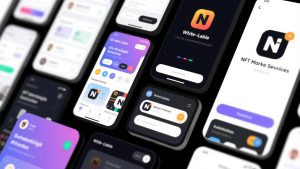White-Label NFT Marketplace Solutions: Cost, Features, and Customization Options
Evaluating White-Label NFT Platform Architectures
The foundation of any successful white-label NFT platform begins with selecting the appropriate technical stack. Modern solutions typically offer modular architectures that allow enterprises to mix and match components based on specific business requirements. The most flexible platforms separate core marketplace functionality from chain-specific implementations, enabling support for multiple blockchains through pluggable adapters. This architectural approach proves particularly valuable for brands needing to maintain presence across ecosystems like Ethereum, Solana, and Polygon. Advanced implementations incorporate layer-2 solutions and sidechains to optimize transaction costs while maintaining security guarantees. The backend infrastructure often combines traditional cloud services with decentralized storage solutions, creating hybrid environments where sensitive user data remains protected while NFT metadata leverages blockchain’s immutability.
Customization depth varies significantly across enterprise blockchain solutions providers. Leading platforms offer everything from superficial branding changes to deep technical modifications including custom smart contract logic and proprietary token standards. The most sophisticated implementations provide visual workflow builders that enable non-technical teams to design unique user journeys without coding. These systems typically include pre-built templates for common use cases like digital art marketplaces, gaming asset platforms, and membership programs, significantly reducing time-to-market. Integration capabilities represent another critical differentiator, with top-tier solutions offering pre-built connectors for popular CRM, payment processing, and analytics tools alongside comprehensive APIs for custom integrations.
Security considerations dominate platform selection criteria for serious custom NFT marketplace implementations. Reputable providers undergo regular third-party audits and maintain bug bounty programs to identify vulnerabilities. The most secure platforms implement multi-signature deployment processes and emergency pause functionality for critical smart contracts. Advanced features like transaction simulation and real-time anomaly detection help prevent costly errors and malicious attacks. Compliance tooling has become equally important, with leading solutions offering built-in KYC/AML verification, tax reporting tools, and jurisdiction-aware content filtering. These features prove essential for brands operating in regulated industries or targeting global audiences with varying legal requirements.
Pricing Models and Total Cost Considerations
The crypto SaaS pricing landscape for white-label solutions spans from simple subscription models to complex revenue-sharing arrangements. Entry-level platforms often charge monthly fees starting around $2,000 for basic functionality, while enterprise-grade implementations can exceed $50,000 per month for fully customized solutions with premium support. Many providers combine flat platform fees with transaction-based revenue shares, typically taking 0.5-2% of marketplace volume. The most sophisticated pricing models incorporate flexible scaling options where infrastructure costs adjust automatically based on usage patterns, preventing surprise bills during traffic spikes.
Hidden costs frequently impact the total expenditure for white-label NFT platform deployments. Blockchain transaction fees, storage costs, and third-party service integrations can add 20-40% to baseline platform fees. Professional services for custom development, migration assistance, and regulatory compliance often represent separate line items in enterprise contracts. The most transparent providers offer all-inclusive packages that bundle these services at predictable rates, though these typically come at premium price points. Smart contract deployment and upgrade costs merit particular attention, as Ethereum mainnet operations can quickly become prohibitively expensive for high-volume marketplaces without proper layer-2 strategies.
Return on investment calculations for enterprise blockchain solutions require careful analysis of both direct and indirect value streams. While platform fees and transaction revenue represent measurable income, brands often derive greater value from secondary benefits like customer engagement metrics and brand equity enhancement. The most successful implementations track platform performance against traditional e-commerce benchmarks while also monitoring web3-specific KPIs like wallet retention rates and average transactions per connected address. These metrics help justify ongoing platform investments and guide future customization priorities. Some forward-thinking organizations now attribute portions of their overall digital transformation budgets to NFT initiatives, recognizing their strategic role in next-generation customer experiences.

Advanced Customization and Future-Proofing
The most sophisticated custom NFT marketplace implementations leverage AI and machine learning to create differentiated user experiences. Personalized recommendation engines analyze on-chain behavior to surface relevant assets, while predictive pricing tools help collectors identify undervalued opportunities. Some platforms now incorporate generative AI directly into the creation flow, allowing users to mint NFTs with dynamic attributes that evolve based on external data inputs. These advanced features require specialized expertise to implement properly, often necessitating dedicated data science teams or partnerships with third-party AI providers. The integration complexity typically justifies itself through increased user engagement and higher average transaction values.
Interoperability features have become critical for future-proof crypto SaaS pricing strategies. Leading platforms now support cross-chain asset bridging, enabling collections to move seamlessly between ecosystems based on market conditions. The most innovative implementations incorporate decentralized identity standards that preserve user reputation and achievements across multiple marketplaces. These features prove particularly valuable for gaming and entertainment applications where digital assets frequently traverse platform boundaries. Upcoming developments in account abstraction promise to further simplify these cross-platform experiences, potentially allowing users to interact with multiple marketplaces through unified interfaces without managing separate wallet credentials.
Governance customization represents another frontier for advanced white-label NFT platform implementations. Progressive decentralization models allow brands to gradually transfer control to community stakeholders while maintaining necessary oversight during early growth phases. The most flexible platforms provide modular governance frameworks that support everything from simple multisig arrangements to complex token-weighted voting systems. These tools enable organizations to align platform evolution with corporate values while accommodating the decentralized ethos of web3 communities. As regulatory clarity improves, expect to see more hybrid models that combine on-chain governance for product features with traditional corporate oversight for legal and financial matters.
